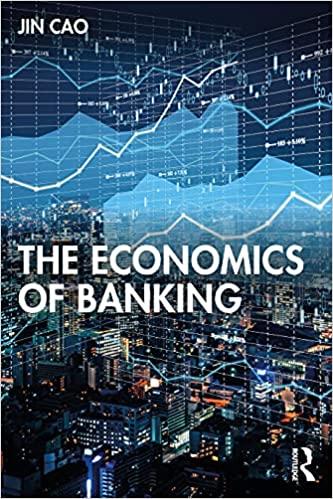Consider a profit-maximizing bank's one-shot decision problem as follows: it can invest 1 dollar in either of
Question:
Consider a profit-maximizing bank's one-shot decision problem as follows: it can invest 1 dollar in either of the two projects
- Project G, which yields a gross return \(R_{G}\) with probability \(p_{G}\), or 0 otherwise;
- Project B, which yields a gross return \(R_{B}\) with probability \(p_{B}\), or 0 otherwise.
Assume that although project B returns more if it is successful, \(R_{B}>R_{A}\), the expected return of project \(G\) is higher, \(p_{G} R_{G}>p_{B} R_{B}\).
The bank does not have any initial wealth, so that it raises funding from issuing \(k,0\leq k \leq 1\) equity capital and collecting \(1-k\) deposits from depositors. The capital ratio \(k\) is a constant that is set by the regulator. Assume that deposits are fully insured, and the premium that the bank has to pay the insurance scheme is normalized to 0. The gross deposit rate \(R_{D}\) is determined by a competitive deposit market so that the bank takes it as given. Equity holders require a gross return to equity (ROE) \(R_{E}\) that is no less than the deposit rate, \(R_{E} \geq R_{D}\).
(a) Compute the bank's expected profit from investing in each type of the projects. Show that project \(G\) is always profitable, as long as \(p_{G} R_{G}>R_{E} \geq R_{D}\).
(b) What is the condition for \(k\) and \(R_{D}\), under which project \(\mathrm{B}\) is more profitable than project \(\mathrm{G}\) ? Is it possible that the profit of project \(B\) is positive, while the profit of project \(G\) is negative?
(c) Now assume that \(R_{D} What capital requirement \(k\) is needed for the regulator, in order to induce the bank to choose project \(\mathrm{G}\) ? (d) Keep the assumption in question (c). Now assume that the representative bank in this economy is making dynamic decisions over an infinite time horizon, \(t=0,1, \ldots,+\infty\). The capital requirement \(k\) is fixed by the regulator in the beginning of the world \(t=0\). In any period \(t\), - The bank receives funding from equity investors and depositors; - Then the bank makes its choice on the project; - In the end of the period, the chosen project returns. If the bank defaults, it is shut down by the regulator and will lose its banking license forever.
i. Assume that the bank's discount factor is \(\beta, 0<\beta<1\). What capital requirement \(k\) is needed for the regulator, in order to induce banks always to choose project \(\mathrm{G}\) in every period?
ii. Explain why your result is different, compared with the result in question (c).
Step by Step Answer:






